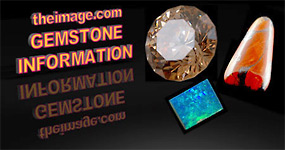
 |
theimage.com | how to facet |
| gemstone main | cabochon creation | |
| min data |
|
Animation of Gemstone Page 5
|
|||
| I had no turn-table capable of auto-rotating the stones so I went to the local Michael's craft store and bought a battery operated wedding cake turn table for about $15. Unfortunately after I got it home it turns out it takes about 45 second for one rotation.
I video taped one rotation using a Sony DV camera and captured the video on my Macintosh in a program called Final Cut Pro. I then re-timed the video to take 10 seconds rather than 45 seconds. For the sake of this discussion just assume it is a 10 second video. I reduced the image size to 320x240 and set the frame rate to 16 fps. I found the turn-table had a bit of jitter at at least one point in each revolution, I put a small mirror over the center of the table and eye-balled placing a stone on the mirror in roughly the center. (Sorry I have no "non-virtual" Paraiba tourmaline.) We'll have to settle for a rose de france amethyst (not from France) and a citrine. The Portuguese Cut citrine is about 16 mm in diameter an the Sparkler Cut amethyst about 17 mm in diameter. I used very simple lighting, two lights (one on each side of a small white light tent) and one light about 45 degrees off the camera lens to provide highlights. The Camera was Sony DV video camera fitted with +2 diopter close up lens. (The close up lens was adapted using a 58mm to 52mm step down ring.) With the close-up lens I moved the camera about 12 inches from the stone and used the zoom and manual focus to frame the picture and bring all into focus. I would expect my real video files to be larger than the "virtual" animations shown earlier. The mirror actually is reflecting a real world surface (the close-up tent) and their is fine detail there that would not have been in the virtual set up. By keeping teh camera lens as far from the objects being photographed, you are giving yourself the mazimum depth of dield you can get. Thus a close-up lens on a longer zoom setting is better than a closer zoon setting. If Iwere trying to make a better pictue, I would increase color saturation a bit, and tone down the lighting a bit. But these mages were to demonstrae file size reduction techniques and not to sell stones. |
|||
| 320 x 240 resolution
10 second duration 15 fps 512 kbps bandwidth on compression file size: 692K |
|||
| The original video was compressed from the DV tape which was 720 x 480 in both cases | |||
| 320 x 240 resolution
10 second duration 15 fps 512 kbps bandwidth on compression file size: 689K |
|||
| The video below was re-compressed using 256 kbps bandwidth and is about 1/2 the size of the original | |||
| 320 x 240 resolution
10 second duration 15 fps 259 kbps bandwidth on compression file size: 326 K |
|||
| Conclusions: 1.) it is not too hard to make 320x240 up to about 480x360, 10 second animations that can run from roughly 300K to about 700K in file size. 2.) use 12 - 16 FPS for the animation speed it is a good trade-off for smooth animation verses file optimization. 3.) keep the subject matter in the center of the frame while spinning, and don't use a mirror unless you can accept about a 20% gain in file size. Use a solid (non-patterned color) for best optimization. 4.) use the bandwidth option in the software to do 1 or 2 pass compression, and set it for about 512K bandwidth, then try it lower but watch for bad color or other weird animation artifacts. (On the Macintosh I used a program called Media Cleaner Pro to compress with the variable bandwidth. It has since been re-named and sold to another company (information here). (It is available for the PC too.) |
|||